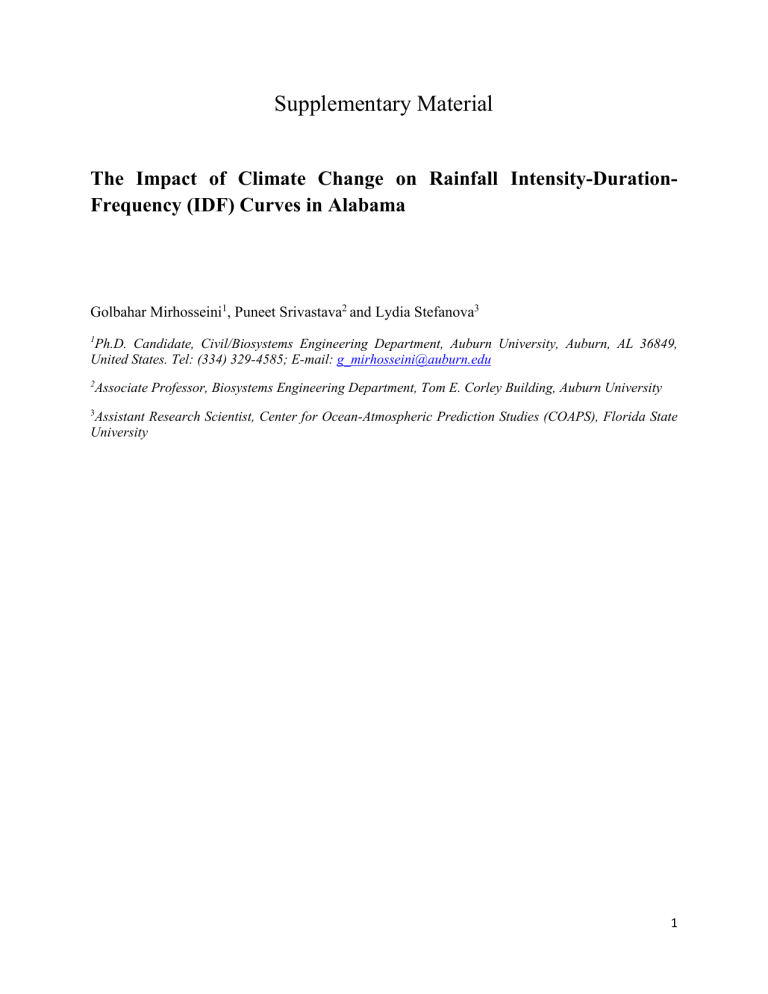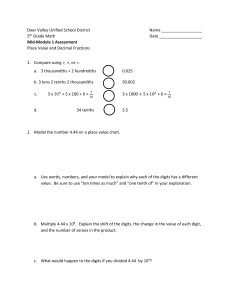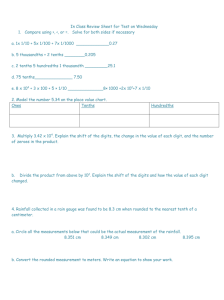(IDF) Curves in Alabama - Springer Static Content Server

Supplementary Material
The Impact of Climate Change on Rainfall Intensity-Duration-
Frequency (IDF) Curves in Alabama
Golbahar Mirhosseini
1
, Puneet Srivastava
2 and Lydia Stefanova
3
1
Ph.D. Candidate, Civil/Biosystems Engineering Department, Auburn University, Auburn, AL 36849,
United States. Tel: (334) 329-4585; E-mail: g_mirhosseini@auburn.edu
2
Associate Professor, Biosystems Engineering Department, Tom E. Corley Building, Auburn University
3 Assistant Research Scientist, Center for Ocean-Atmospheric Prediction Studies (COAPS), Florida State
University
1
Online Resource 1 Location of rain gauge stations (red squares) and NARCCAP 50-km resolution grid centers
(green dots, HRM3-HadCM3) used for developing IDF curves for Alabama.
2
Supplementary material on temporal downscaling method
The downscaling method used in this study was adopted from Socolofsky et al (2001). As explained in the manuscript, for the purpose of downscaling, a month-specific database of observed precipitation data was created. This database includes several observed rainfall events with high temporal resolution (15 minute interval). An “event” was defined as a continuous sequence of precipitation, separated by 30 minutes of dry weather. In case an event was longer than 3 hours, it was further divided into 3-hr subintervals starting from the beginning of the rainfall. As such, the database was composed of multiple years of observed events, separated by month, where each event was no longer than 3 hours.
For each month in the database (August as an example), the events were sorted based on their total accumulated rainfall depth and created a CDF using the rainfall depths, such that each point on the CDF corresponds to actual, measured storm event in the database. In other words, each observed event is corresponded with a probability.
To disaggregate a 3hr GCM forecast for August 1 st , 2038 between 9:00 to 12:00 AM, with a magnitude of 300 mm (call it D
T
), the downscaling algorithm stochastically selects several
(and not one) observed events from the database and distributes them randomly over the 3-hr period. This means, the algorithm follows these steps:
1Given a 3-hourly rainfall with magnitude of D
T
, the algorithm first searches the historic CDF for the ordinate “a” corresponding to D
T
.
2- A random number is generated from uniform distribution between 0 and “a”, call it
“u
1
”
3- “u i
” is the probability of the randomly selected historic event. The magnitude of the observed event with probability of “u i
” is read from the historic CDF (name it D i
) and its distribution is retrieved from the database.
4- New D
T
is calculated by subtracting D i
from D
T
.
5- This process then repeats for the new D
T
6- Stop when n is the number of observed events selected.
One of the statistics used to evaluate the performance of the disaggregation method was
“zero rainfall probability”. According to the explained method, the stochastic algorithm selects a number of observed events randomly from a database and distributes them stochastically over a
3-hr period (12 time slots of 15 minutes). Some of the slots might remain empty (no rainfall) or
3
not. The final product is a newly generated distribution which has no similarity to any of the individual historic events. For validation, the algorithm was run 30 times on some selected events with known distribution and reported the average metric. Since the method is stochastic, for each run, different historic events are selected from the database and randomly distributed over 12 time slots. So the “zero rainfall probability” yielded from each run is different from the other.
The other statistic used for validation of the method was performance measures between the maximum rainfall of disaggregated time series compared to reference rainfall. As explained earlier, several reference rainfalls with known distributions were selected and disaggregated using the explained scheme. The resultant distributions were compared to the reference distribution and the statistical analysis was performed to acquire the goodness of fit measures
(e.g. R
2
of zero rainfall probability and maximum rainfall). When a single 3-hr event was disaggregated, the maximum partial rainfall depth for a given period within that event was calculated. These maximums are not compared by taking the max of the monthly or annual disaggregated rainfalls but by taking the maximum of disaggregated selected events (mostly large events) for each month and rainfall duration. For any of these events, the model was run 30 times and the mean statistics was presented.
4
Online Resource 2 Performance measures between the disaggregated time series and measured statistics of 15-min rainfall
Month Station
February Auburn, AL
Statistics R 2
P
0
σ 2
0.91
0.82
August Auburn, AL
P
0
σ 2
0.82
0.78
MAE
0.01
0.0003
0.05
0.002
RRSE
0.31
0.62
0.69
0.81
P
0
: probability of zero rainfall, σ 2 : the variance of 15-min rainfall, R 2 : linear regression, MAE: mean absolute error and RRSE: root relative squared error
Online Resource 3 Performance measures between the maximum rainfall of disaggregated time series and measured statistics
R 2 MBE * min 15 30 45 60 120 15 30 45 60 120
Jan 0.87 0.92 0.90 0.90 0.80 14.6 -9.08 -10.9 -9.5 -8.9
Feb 0.95 0.85 0.78 0.73 0.75 -8.57 -10.8 -10.4 -11.5 -7.4
Mar 0.92 0.92 0.91 0.90 0.79 17.6 -3.9 -10.6 -10.03 -10.3
Apr 0.93 0.95 0.89 0.85 0.84 7.42 -9.7 -8.6 -8.4 -8.21
May 0.97 0.92 0.83 0.81 0.77 -5.9 -7.5 -8.3 -9.2 -10.4
Jun 0.92 0.88 0.78 0.75 0.60 -6.7 -11.1 -9.3 -9.8 -12.9
Jul 0.92 0.89 0.84 0.73 0.80 5.01 -9.8 -10.7 -9.2 -8.97
Aug 0.91 0.90 0.81 0.77 0.60 8.40 -8.18 -9.2 -10.4 -9.6
Sep 0.96 0.91 0.85 0.76 0.80 3.2 -9.2 -8.6 -8.1 -8.9
Oct 0.87 0.90 0.94 0.85 0.81 9.02 -9.8 -9.5 -11.5 -8.4
Nov 0.92 0.92 0.92 0.90 0.90 24.6 -6.4 -9.4 -8.9 -4.9
Dec 0.91 0.95 0.94 0.90 0.90 12.9 -6.8 -8.3 -10.8 -9.7
Ave. 0.92 0.91 0.87 0.82 0.80 9.23 -10.36 -11.84 -7.78 -10.22
* MBE: Mass Balance Error
5
Online Resource 4 Performance measures between the sample and theoretical cumulative distributions using
Kolmogorov-Smirnov (K-S) test
Models
HRM3-HadCM3
CRCM-CGCM3
HRM3-GFDL
Average
0.092
0.086
0.089
0.087
Kolmogorov-Smirnov
Max
0.201
0.195
0.175
0.178 CRCM-CCSM
RCM3-GFDL 0.104 0.218
ECP2-GFDL 0.088 0.178
The critical value at α=0.05 is 0.234
* Standard deviation
** Coefficient of determination
Min
0.043
0.039
0.038
0.035
0.042
0.031
Std.*
0.026
0.024 0.982
0.024
0.981
0.023 0.982
0.034
0.024
Average
0.980
0.971
0.982
R 2 **
Max
0.996
0.996
0.996
0.997
0.997
0.997
Min Std.*
0.926 0.011
0.937 0.010
0.922 0.011
0.933 0.01
0.910
0.01
0.933 0.01
6
Online Resource 5 Rainfall intensity map; 50-year rainfall of 6-hr, 12-hr, 24-hr and 48-hr durations (mm) under future climate using HRM3-HadCM3 projected data
7








